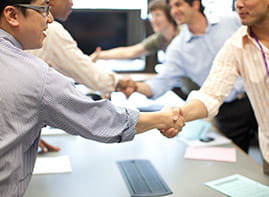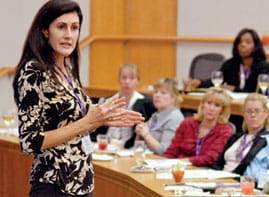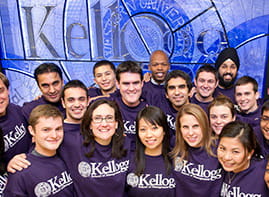The U.S. medical technology market is worth an estimated $110 billion, according to the U.S. Department of Health and Human Services.
Many Kellogg alumni want to see that figure grow.
Cheaper to bring to market than new drugs and often cheaper on the consumer, medical devices make up an increasing portion of the tools used in public health care. However, the U.S. Food and Drug Administration has the world’s most demanding and expensive process for approving medical devices.
From incubators to startups to venture capital firms, here are just a few members of the Kellogg network to bring life- and wallet-saving health innovations through that process to market.
The doctors
A medical device starts with an idea, often one generated by doctors working in the field.
That’s how a team of Northwestern Memorial Hospital surgeons, including David Mahvi and Dan McCarthy ’13, the latter a graduate of Kellogg’s MMM program and a fellow at
Northwestern’s Center for Device Development, developed a cancer treatment device coming to the market through startup Innoblative.
The device is placed into the tumor cavity following a lumpectomy and destroys any residual cancer cells, rendering radiation therapy unnecessary. But
Innoblative CEO Tyler Wanke ’15, a MMM student and MD candidate, said they're months, if not years, away from seeking FDA approval.
“The biggest surprise was probably how in-depth, arduous and long the regulatory process was,” Wanke said.
The FDA sorts about 1,700 different types of medical device into three “classes” based on danger to the patient. Each class has its own approval process, plus any variance the FDA asks for based on the device’s particulars. (Is it radioactive? Is it implanted? Is this a new version of an old device or an entirely new thing?)
All these details separate a Class 1 510(K)-exempt Product Code JES from a Class 3 PMA-path Product Code DXY.
Or, as you might call them,
dental floss and
pacemakers.
The regulatory process doesn’t end once the product is on the market. Intersect ENT’s sinus implants ended up having to go through the Pre-Market Approval, or PMA, path. With this, the FDA’s most stringent and expensive device pathway, any changes in the product or even the manufacturing post-market must go back to the FDA for approval.
“We moved to a new facility just up the road five miles from Palo Alto to Menlo Park and we had to do a full submission to get the FDA to approve the facility,” said CEO Lisa Earnhardt ’96.
Despite the costs, the rewards are there for companies that make it to market.
Intersect ENT went from a 12-person startup to a 200-person company and won the American Rhinologic Society’s Cottle Award for Best Clinical Science Research. The Silicon Valley Business Journal recognized them this fall as the fastest growing company in Silicon Valley. Forbes honored them as one of "America's Most Promising Companies."
The INCUBATORS
Health-tech incubators like Chicago-based
MATTER try to help medical professionals turn raw ideas and pre-market startups into Intersect-level success stories.
The incubator, which Clinical Assistant Professor of Innovation & Entrepreneurship
David Schonthal formed with Kellogg grads Andrew Cittadine ’98 and Steven Collens ’01, brings the doctors and clinicians who created a device together with the payers, venture capitalists and regulatory consultants who can shape it into a viable business.
Schonthal said he tries to fight the “solution hunting for a problem” mentality by challenging the innovators with a simple question: Why should this product exist?
“Just because it works in a lab doesn’t mean there’s a need for it in the market,” he said.
Not all ideas, no matter how technically proficient, are worth pursuing, he said.
“Sometimes the most humane thing you can do for a technical founder is stop them from wasting their time,” Schonthal said.
THE ANGELS
Even if a device is viable, it takes money to become a full-fledged product. A lot of money. That’s where venture capitalists like Marc-Henri Galletti ’97 come in.
Galletti is the co-founder and managing director of venture capital firm
Longitude Capital, which specializes in life sciences and has two active funds with over $700 million in commitments.
A “stage-agnostic investment firm,” Longitude will consider investing in medical device startups at any point in their development. The important part is the company, with Longitude's support and assistance, should be able to hit the next key value-creating milestone, whether that's proof of concept, FDA approval or settling into a post-market niche within three to five years.
“If the company has a challenge getting over those hurdles, then we have to have a very difficult discussion about whether we want to continue with this company,” Galletti said.
Just as angel investors invest in many companies, the companies hunt for multiple funding sources. Innoblative, for example, has won nearly $200,000 in funding through 11 top business plan and case competitions, has taken a new office and lab space through
Insight Product Development’s accelerator lab and has even taken to the Internet, raising money through
Medstartr, a Kickstarter-like crowdfunding site.
WHY SO EXPENSIVE?
On the surface, it seems much cheaper to make a medical device than a drug. Part of that reason is that the FDA requires large-scale Phase 3 clinical trials, which can often put the cost of getting a drug to market past the $1 billion mark.
However, Arun Menawat ’96, CEO of medical imaging company
Novadaq, said the true cost of a medical device isn’t necessarily less, just backloaded.
Phase 3 studies, while expensive, definitively show the medical profession how well the drug works. Device testing shows that a treatment is safe, not that it’s more effective than competitors.
“On the device side, once you get the regulatory approval, that gives you license to really start the business,” Menawat said. “You may have the best product, but it still may take two to three years before adoption occurs, because the surgeon is used to using his own device and you’re asking him to make a change.”
Menawat said some device companies invest in multi-center studies of their product after it’s on the market, working with numerous hospitals basically to replicate the testing that would have gone into a Phase 3 trial. Only about 10 percent of companies invest in such studies, he said. He expects that number to rise.
Costs borne in the usa
Depending on whom you ask, the FDA’s process can be a good thing or a bad thing.
Menawat’s Canada-based company sought approval in the U.S. first, then used the rigorously tested data to get approval in countries with less demanding standards.
“If we’ve done the work in the U.S., effectively we’ve done the work for the rest of the countries,” he said.
Innoblative, however, is considering launching in Europe first, after obtaining a CE mark — the European Union seal of product safety.
“If you can get your device to market in Europe, you do that, you learn, you make some money and you get your product out there helping people sooner,” Wanke said.






